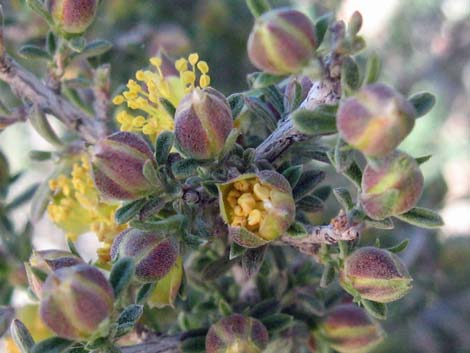
Shrubs Around Las Vegas, Vegetation Around Las Vegas
 Extensive stand of nearly pure blackbrush |
General: Blackbrush (Coleogyne ramosissima) is a common, often dominating component of middle-elevation slopes and upper bajadas in the Upper Sonoran (Mojave Desert Scrub) life zone. Blackbrush is most common at the interface of the Mojave Desert Scrub and Pinyon-Juniper Woodland habitat types. At these middle elevations, when you look out across the landscape, the low, blackish shrub covering the ground is Blackbrush. Often it is easier to identify Blackbrush at a distance on a hillside than it is to identify it in the hand. When walking through a stand of Blackbrush, however, the spiny stems will remind you of who they are. Blackbrush, Joshua Trees, and Mojave Yuccas form a vegetation association (Blackbrush Shrublands) unique to the Mojave Desert that helps define the boundary of the Mojave Desert and the Great Basin Desert when Creosote bush is absent. |
 Blackbrush in bloom |
Family: Rose (Rosaceae). Other Names: Coleogyne. Plant Form: Low growing, rounded shrub with a dense crown. Blackish color. Height: Usually about knee-high, to 5 feet. Bark: Dark gray to blackish; light gray fissures. Bark becomes darker with age and when wet. Stems: Stiff, opposite, and widely divergent, often sharp and spine-like at the tip. Leaves: Small, gray-green, and aromatic. Leaves in fasciculated, opposite clusters; linear, usually about 1/2 inch long, edges entire and rolled under. Leaf surface hairy. Drought deciduous. |
 Blackbrush flowers (typical wildrose flowers) |
Flowers: Small, yellow, single at the ends of twigs; appears to have four petals, but the "petals" are actually sepals. Many stamens. The stamens emerge before the flower fully opens, giving the appearance of flowers without petals. Seeds: Crescent shaped, brown, about 1/4 inch long. Habitat: Dry, well-drained sandy, gravelly, and rocky soils on upper bajadas and moderate slopes in the lower mountains. Elevation: 2,000 to 5,000 feet. Distribution: Southwestern U.S. Comments: Blackbrush is a "masting" species, which means that usually it produces few seeds, but periodically it produces many seeds. When a species masts, it produces so many seeds that the seed-eating creatures can't possibly eat them all, so more seeds have a chance to survive. In the case of Blackbrush, rodents gather up and bury the seeds, hoping to eat them later, but there are so many seeds that some seed caches have a chance to sprout. This causes another phenomenon where what appears to be a single bush is actually the intertwined stems of several bushes -- all growing from a seed cache. |
 Extensive stand of nearly pure blackbrush |
 Blackbrush-Joshua Tree association Blackbrush-Joshua Tree association |
 |
 |
 |
 |
 Leaves small, gray-green, and usually to about 1/2 inch long |
 Leaves small, gray-green, and usually to about 1/2 inch long |
 Leaves in fasciculated clusters; leaf surface hairy |
 Leaves in fasciculated clusters; leaf surface hairy |
 Leaves in fasciculated clusters; leaf surface hairy |
 Leaves in fasciculated clusters; leaf surface hairy |
 Developing flower bud |
 Flower bud opening |
 Stamens emerge before the flower fully opens |
 Stamens emerge before the flower fully opens |
 Stamens emerge before the flower fully opens |
 Stamens emerge before the flower fully opens |
 |
 |
 |
 |
 |
 |
 |
 |
 |
 |
 Dried sepals remain on the plant long into winter |
 Dried sepals remain on the plant long into winter |
 Weather-beaten plant during fall |
 A few dried flowers stay on the plant into the winter |
Note: All distances, elevations, and other facts are approximate. Names generally follow the USDA database.
![]() ; Last updated 241201
; Last updated 241201
| All Shrubs | Plant Species Index | Glossary | Copyright, Conditions, Disclaimer | Home |